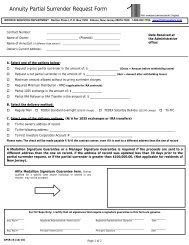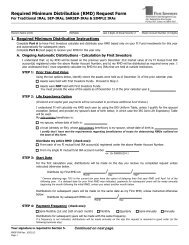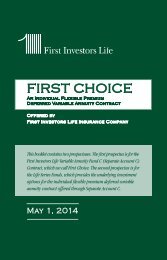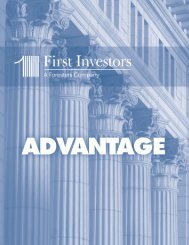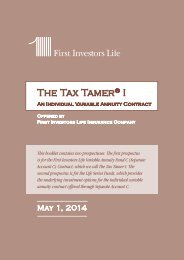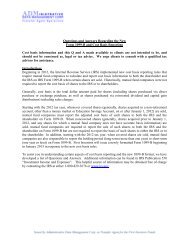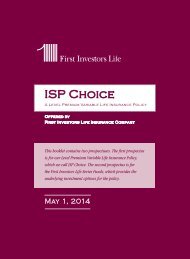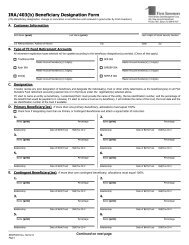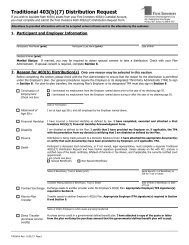Life Series Funds - First Investors
Life Series Funds - First Investors
Life Series Funds - First Investors
You also want an ePaper? Increase the reach of your titles
YUMPU automatically turns print PDFs into web optimized ePapers that Google loves.
Understanding Your Fund’s Expenses<br />
FIRST INVESTORS LIFE SERIES FUNDS<br />
As a mutual fund shareholder, you incur two types of costs: (1) transaction costs, and<br />
(2) ongoing costs, including advisory fees and other expenses. This example is intended<br />
to help you understand your ongoing costs (in dollars) of investing in the Fund and to<br />
compare these costs with the ongoing costs of investing in other mutual funds.<br />
The examples are based on an investment of $1,000 in each Fund at the beginning of<br />
the period, January 1, 2013, and held for the entire six-month period ended June 30,<br />
2013. The calculations assume that no shares were bought or sold during the period.<br />
Your actual costs may have been higher or lower, depending on the amount of your<br />
investment and the timing of any purchases or redemptions.<br />
Actual Expense Example:<br />
These amounts help you to estimate the actual expenses that you paid over the period.<br />
The “Ending Account Value” shown is derived from the Fund’s actual return, and the<br />
“Expenses Paid During Period” shows the dollar amount that would have been paid by<br />
an investor who started with $1,000 in the Fund. You may use the information here,<br />
together with the amount you invested, to estimate the expenses that you paid during<br />
the period.<br />
To estimate the expenses you paid on your account during this period simply divide<br />
your ending account value by $1,000 (for example, an $8,600 account value divided by<br />
$1,000 = 8.60), then multiply the result by the number given for your Fund under the<br />
heading “Expenses Paid During Period”.<br />
Hypothetical Expense Example:<br />
These amounts provide information about hypothetical account values and hypothetical<br />
expenses based on the Fund’s actual expense ratio and an assumed rate of return of<br />
5% per year before expenses, which is not the Fund’s actual return. The hypothetical<br />
account values and expenses may not be used to estimate the actual ending account<br />
balance or expenses you paid for the period. You may use this information to compare<br />
the ongoing costs of investing in the Fund and other funds. To do so, compare this 5%<br />
hypothetical example with the 5% hypothetical examples that appear in the shareholder<br />
reports of the other funds.<br />
Please note that the expenses shown in the table are meant to highlight and help you<br />
compare your ongoing costs only and do not reflect any transactional costs. Therefore,<br />
the hypothetical expense example is useful in comparing ongoing costs only, and will<br />
not help you determine the relative total costs of owning different funds. In addition, if<br />
these transactional costs were included, your costs would have been higher.<br />
4




